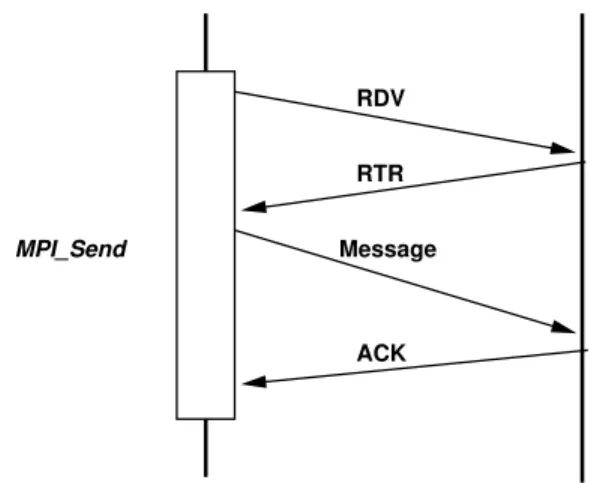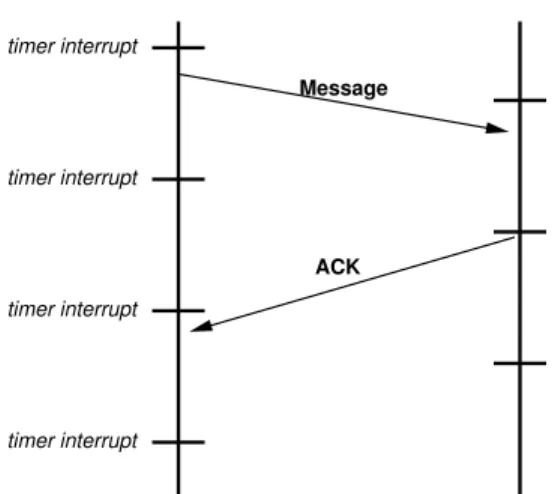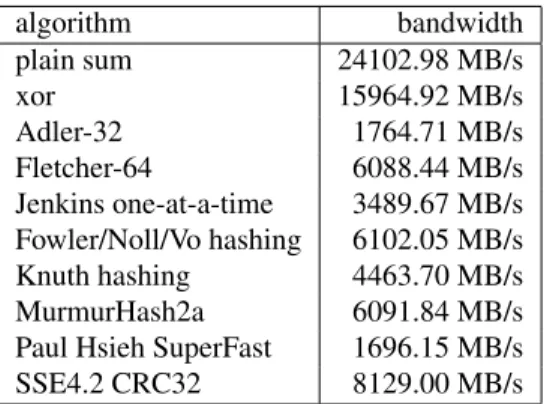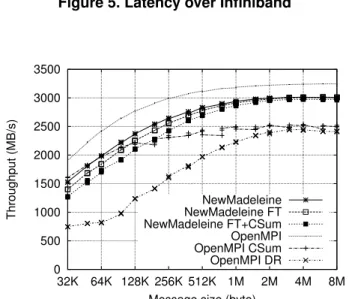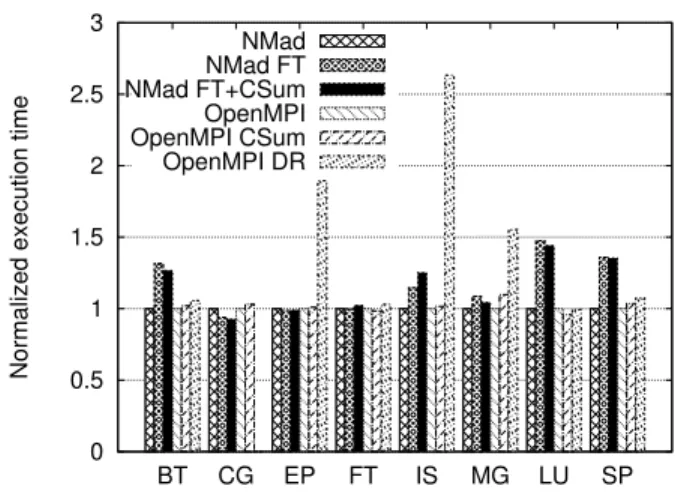HAL Id: hal-00793176
https://hal.inria.fr/hal-00793176
Submitted on 22 Feb 2013HAL is a multi-disciplinary open access archive for the deposit and dissemination of sci-entific research documents, whether they are pub-lished or not. The documents may come from teaching and research institutions in France or abroad, or from public or private research centers.
L’archive ouverte pluridisciplinaire HAL, est destinée au dépôt et à la diffusion de documents scientifiques de niveau recherche, publiés ou non, émanant des établissements d’enseignement et de recherche français ou étrangers, des laboratoires publics ou privés.
A Generic and High Performance Approach for Fault
Tolerance in Communication Library
François Trahay, Alexandre Denis, Yutaka Ishikawa
To cite this version:
François Trahay, Alexandre Denis, Yutaka Ishikawa. A Generic and High Performance Approach for Fault Tolerance in Communication Library. [Research Report] INRIA Bordeaux. 2010. �hal-00793176�
A Generic and High Performance Approach for
Fault Tolerance in Communication Library
François Trahay
1Alexandre Denis
2Yutaka Ishikawa
11 RIKEN, University of Tokyo,
{trahay,ishikawa}@il.is.s.u-tokyo.ac.jp
2 I
NRIA, LABRI
alexandre.denis@inria.fr
Abstract
With the increase of the number of nodes in clus-ters, the probability of failures increases. In this paper, we study the failures in the network stack for high performance networks. We present the design of several fault-tolerance mechanisms for communication libraries to detect failures and to ensure message integrity. We have implemented
these mechanisms in the NEWMADELEINE
com-munication library with a quick detection of fail-ures in a portable way, and with fallback to avail-able links when an error occurs. Our mechanisms ensure the integrity of messages without lowering too much the networking performance. Our eval-uation show that ensuring fault-tolerance does not impact significantly the performance of most ap-plications.
1
Introduction
Since the development of large scale supercom-puters have led to systems composed of hundreds of thousands of components, the likelihood of hardware or software failure becomes embarrass-ing. The design of future supercomputers fore-shadows an increasing number of components, decreasing the mean time between failures [4]. Among the common causes of failures, the crash of computing nodes can be bypassed by using
check-point and restart mechanisms. However, failures may also happen on the network – a switch can fail or a NIC may crash – and communication libraries thus have to support such failures and maintain the connectivity between nodes as much as possible.
In this paper, we present a generic retransmis-sion mechanism that permits to reroute automat-ically the communication flow through surviving links when a network failure occurs. The orig-inality of our work consists in two mechanisms: quick network failure detection, and low-overhead checksums to ensure data integrity.
The remainder of this paper is organized as fol-lows: Section 2 presents related work. Section 3 describes the design of the retransmission mecha-nism. The fault-detection mechanism is presented in Section 4 and the technique used for ensuring message integrity is described in Section 5. Re-sults are discussed in Section 6 and we draw a con-clusion in Section 7.
2
Related work
The advent of large scale supercomputers as well as grid computing have led to numerous re-searches on fault-tolerance. Various works have focused on surviving to node failures by using checkpointing mechanisms. However, the whole software stack has to be fault-tolerant and several researches have been conducted to make MPI im-plementations capable of supporting dynamic
dis-connection and redis-connection. MPICH-V [3] uses a virtual channel mechanism that abstracts con-nections between nodes and permits to respawn a crashed process without losing messages. FT-MPI [5] supports process failures by allowing
dy-namic resizing of MPI communicators. These
mechanisms permit to survive a process or network failure at the expense of high overhead. The causes of the invocation of these mechanisms – network or process failures – should thus be avoided.
Various researches were conducted on provid-ing fault-tolerant communication libraries able to survive network failures. Some studies have fo-cused on detecting network errors by using ping-ing or heart beat techniques [2]. However, this may lead to unnecessary messages on the net-work and it can be problematic for large number of processes. Most fault-tolerant communication libraries for high performance networks thus use a sender-based logging mechanism [15]: when a message is received, an acknowledgment is sent back. If the sender process does not receive the acknowledgment before a timeout, the network is assumed to have failed. Generic MPI implementa-tions usually use a multi-second timeout, but since some network interfaces provide hardware time-out, specific MPI implementations can use them for detecting failures in a few milliseconds [7]. Detecting network failure rapidly while preserv-ing the portability is thus difficult with current MPI implementations.
Since altered messages are likely to false the re-sults of applications, various researches have fo-cused on ensuring the integrity of MPI messages.
LA-MPI [6] or OPEN MPI [12] compute
check-sums on transferred messages and are able to re-transmit corrupted fragments. This ensures the in-tegrity of messages, but the overhead introduced by the computation of checksums may signifi-cantly impact the performance of applications.
When a network failure is detected, the com-munication library needs to recover from this er-ror. On IP networks, it is possible to use an
al-ternative route that may be safe [10]. For
In-finiband networks, MVAPICH2 [8] tries to recon-nect or to reload the HCA driver, before rerouting messages to another Infiniband HCA. RI2N [11] can exploit several Ethernet links and fallbacks to surviving links when a network becomes unavail-able. MPI implementations that support heteroge-neous multirail can reroute messages to another
network. Most supercomputer being equipped
with both high speed network and Ethernet, this latter technique permits to maintain connections between nodes in case a network fails.
3
Surviving network failures
In order to avoid using heavy recovery mecha-nisms at the application level, it is necessary for the communication library to survive network fail-ures. An issue occurring on the network – a switch crashing for example – or on a remote node – a process crashing or a remote NIC failure – should not cause the local process to crash. The commu-nication library thus has to handle network errors and ensure that no message is lost.
In this Section, we present the recovery
mecha-nism implemented in the NEWMADELEINE
com-munication library [1] that permits to ensure these
properties. Since NEWMADELEINE can exploit
several networks simultaneously, a failure happen-ing on a network can be overridden by rerouthappen-ing the traffic to other links. Since most supercomput-ers are connected through one or more high speed networks as well as through Ethernet, this permits to survive at least one network failure: the applica-tion benefits from the fast network and can rvert to the slow one in case of failure.
Recovering from a network failure requires to stop using the faulty link and to retransmit all the
messages that may have been lost. Since NEW
-MADELEINEmaintains a list of available links for each connected process, this can be done by chang-ing the state of the faulty link. When communicat-ing with the remote process for which the error was 2
free buffer Message
ACK MPI_Send
Figure 1. Reliability protocol for eager mes-sages
detected, the faulty driver will not be use. How-ever, the driver remains available for other pro-cesses. The retransmission of messages requires to know which one were actually received, thus NEWMADELEINE uses a sender-based message
logging: messages are kept in memory until the re-ceiving process notifies their reception. As it is de-picted in Figure 1, for messages transmitted using
a eager protocol NEWMADELEINEcopies the data
into a pre-registered buffer, the data is thus freed when the corresponding acknowledgment message is received. Figure 2 illustrates the case of large messages that use the rendezvous protocol: since NEWMADELEINE does not copy the data, the
ap-plication is notified that the message was sent only when the acknowledgment is received. It is to be
noted that, since NEWMADELEINE can aggregate
messages, acknowledgments can be merged into data messages, reducing the overhead to a message aggregation.
When a network failure is detected, NEW
-MADELEINE retransmits all pending messages
through one of the remaining links. The receiver detects duplicate messages using their sequence number.
This generic retransmission mechanism thus permits to survive to network errors as long as a route to the remote process exists. If a remote NIC crashes, messages are rerouted using another NIC. If a network fails – cable or switch failure – mes-sages are rerouted and other errors may be detected
RDV
RTR
ACK Message MPI_Send
Figure 2. Reliability protocol for rendezvous
messages
from links that use the faulty hardware. If a re-mote process crashes, messages are rerouted using available NICs until all the links to this node are disabled. The process is then considered as un-reachable and the application should be notified.
4
Detecting network failures
The retransmission mechanism described in Section 3 being based on message logging, the memory consumption depends on how fast ac-knowledgment messages are sent back. Ensuring fast reply to messages and detecting network fail-ures quickly thus permits to reduce the impact of fault tolerance on memory consumption.
The low-level drivers used in NEWMADELEINE
can provide useful information on network fail-ures. Most network interfaces can report errors that happen during message transmission. How-ever the reactivity to these network errors can be slow – for instance, the MX interface only supports multi-second timeouts – and such mechanism can-not detect every errors. Reacting to the drivers no-tifications is thus not sufficient.
Since the retransmission mechanism uses mes-sage logging, each outgoing mesmes-sage induces an 3
Message ACK timer interrupt timer interrupt timer interrupt timer interrupt
Figure 3. Detection of network failures in
NEWMADELEINE
acknowledgment. If NEWMADELEINE detects
that an acknowledgment was not received before a timeout expires, it assumes that a network fail-ure happened. Choosing the timeout value can be tricky since a small value may lead to many false positives while waiting for too long may cause high memory consumption. Moreover, if the re-ceiver process entered a computing phase, it may not let the communication library poll the network, delaying the acknowledgment for several seconds and leading to an incorrect network failure detec-tion.
Using the PIOMan event manager, we
showed [14] that NEWMADELEINE is
guar-anteed to detect network events within one
scheduler timeslice. Even during heavy
com-puting phases, NEWMADELEINE is scheduled
through a timer interrupt, typically every 10 ms. As depicted in Figure 3, a message sent to a process is detected during the next timer interrupt in the worst case, and immediately acknowl-edged. Thus, when sending a message through
the network, NEWMADELEINE can guarantee
that acknowledgments arrive within 3 timeslices, unless a network failure occurs. Pending messages are periodically checked for expired timeouts.
In that case, we assume that a network failure occurred and use the retransmission mechanism described in Section 3.
5
Ensuring message integrity with low
overhead
On their way from the sender memory through the receiver memory, messages may be corrupted with some bits flipped. It may occur on the wire, in the NIC, or on the PCIe bus. Most network hard-ware use checksums internally to ensure message integrity on the wire, but corruption may occur at any other given point.
5.1 Adding checksums on the data path
To ensure end-to-end message integrity, in NEWMADELEINE we use a classical approach
based on checksums. The sender computes a
checksum of the message to be sent, and sends this checksum with the message headers. The receiver then computes the checksum on the received mes-sages. If the computed checksum doesn’t match the one received alongside the data, it means cor-ruption occurred: either the data, the headers, or the checksum itself have been corrupted during the transfer. In this case, we ask the generic layer to retransmit the packet, as described in Section 3.
However, computing checksums has a cost that may lower the available bandwidth. Our approach consists in amortizing the cost of checksum com-putation by combining the checksum and the mem-ory copy wherever it happens.
Figure 4 shows the bandwidth of some check-sums and hashing functions (that may be used as checksums) on our jack cluster, equipped with dual-core Xeon X5650 at 2.67 GHz, on 32 kB
blocks that fit the L1 cache. On this machine,
the memory bandwidth for reading is 9700 MB/s
and the copy bandwidth is 4530 MB/s. Thus,
the simplest checksum algorithms are memory-bound. We propose to compute the checksum on 4
algorithm bandwidth plain sum 24102.98 MB/s xor 15964.92 MB/s Adler-32 1764.71 MB/s Fletcher-64 6088.44 MB/s Jenkins one-at-a-time 3489.67 MB/s Fowler/Noll/Vo hashing 6102.05 MB/s Knuth hashing 4463.70 MB/s MurmurHash2a 6091.84 MB/s Paul Hsieh SuperFast 1696.15 MB/s SSE4.2 CRC32 8129.00 MB/s
Figure 4. Bandwidth of some checksum algo-rithms on 32 kB blocks.
the fly at every place where data is copied in NEW
-MADELEINE; once data has been fetched in cache during the copy, we can expect the checksum to get the same bandwidth as results of Figure 4.
The plain sum is the fastest, and is likely to al-ways be on any hardware. However, it cannot re-liably detect corruption beyond a single bit. If the user wants a better checksum than plain sum to de-tect corruption larger than a single bit, we use the SSE 4.2 CRC32 checksum if available on the given hardware, or the Fletcher-64 checksum else [9].
5.2 Checksums for eager send
In NEWMADELEINE, small packets are sent
with an eager protocol. Data is copied to add
the headers and to apply optimization strategies such as aggregation of multiple messages into one packet. We add the checksum computation im-mediately following the copy, when data is still in
cache. On the receiver side, NEWMADELEINE
re-ceives packets in its internals buffers, then parses headers, performs matching, and unpacks data to its final destination in the user buffers. We add the checksum computation for the received data immediately after this copy, while data is still in cache.
Let λnet and Bnet be the latency and bandwidth
of the network; Bcopy the bandwidth of memory
copy, and Bcsum the bandwidth of checksum
com-putation for data already in cache, then the total transfer time for a message of length L sent with eager mode is:
T (L) = 2 × L Bcopy + 2 × L Bcsum + λnet+ L Bnet
On the jack cluster, equipped with ConnectX2
Infiniband QDR HCA, we have λnet = 1.4 µs;
Bnet = 3 GB/s; Bcopy = 4.5 GB/s; Bcsum =
24.1GB/s. Then we can compute the expected overhead of checksums to be 7 % on 4 kB
mes-sages and 10 % on 32 kB mesmes-sages. We get
the same order of magnitude for the overhead of checksum – from 5 % to 10 %– on other clusters.
5.3 Checksum with rendezvous
Large messages are sent through a rendezvous
protocol in NEWMADELEINE. In this case, our
strategy to compute checksums depends on the un-derlying driver.
For Infiniband, NEWMADELEINE implements
two different strategies for memory registration: dynamic registration of data, with a registration cache (rcache); or memory copy through a pre-registered memory buffer, with a variable depth super-pipeline to overlap copy and send (pipeline). Since this later method uses a memory copy, it is very easy to add the checksum computation on the fly on both sender and receiver sides. We actually interleave memory copy and checksum computa-tion with sub-blocking at the size of L1 cache, to reduce the overhead of checksum. To ensure over-lap of copy and send operations, this pipeline re-lies on the copy bandwidth to be higher than the network bandwidth. When we add checksums, the bandwidth of copy+checksum is still higher than network, so the impact of checksums on pipeline performance is expected to be low.
On other networks, NEWMADELEINEperforms
no memory copy. In this case, our approach
to amortize the cost of checksums consists in computing checksums in PIOMan asynchronous 5
ltasks [13] as soon as the users posts the send re-quest, without waiting for the receiver reply. There is thus an overlap of the rendezvous roundtrip and the checksum computation. Moreover, we com-pute the checksum in parallel in multiple ltasks so as to fully exploit the available CPU cores.
6
Evaluation
In this Section, we present the results obtained
by comparing the original NEWMADELEINEwith
the fault-tolerant NEWMADELEINE. We evaluate
the raw overhead of fault-tolerance mechanisms as well as their impact on NAS Parallel Bench-marks. We also present results obtained with the
current development version of OPEN MPI. Its
csum component performs data integrity checks
but cannot correct corruption errors, and the dr component also detects network failures and sup-ports message retransmission.
The results that we present were obtained on the PLAFRIM and CLUSTER0 platforms. Each node
of the PLAFRIMcluster is composed of two
quad-core Xeon CPUs (X5550) running at 2.66 GHz. Each node features 24 GB of RAM and one
In-finiband QDR HCA. The CLUSTER0 testbed is
composed of nodes equipped with two dual-core Opteron CPUs (2214 HE), 4 GB of RAM and one Myrinet Myri-10G NIC.
6.1 Raw overhead
We now present the results obtained with a ping pong program on Infiniband and Myrinet. The la-tency obtained on Infiniband is reported in
Fig-ure 5. OPEN MPI csum causes an overhead
of 100 ns, while the fault-tolerant version de-grades the latency by 1.3 µs. The message
re-transmission mechanism implemented in NEW
-MADELEINE causes an overhead of 500 ns. This lighter overhead is due to the ability to aggregate messages: the acknowledgment is aggregated with the application message so that only one packet
0 1 2 3 4 5 6 7 8 1 2 4 8 16 32 64 128 256 512 1K 2K Latency (µs)
Message size (byte) NewMadeleine NewMadeleine FT NewMadeleine FT+CSum OpenMPI OpenMPI CSum OpenMPI DR
Figure 5. Latency over Infiniband
0 500 1000 1500 2000 2500 3000 3500 32K 64K 128K 256K 512K 1M 2M 4M 8M Throughput (MB/s)
Message size (byte) NewMadeleine NewMadeleine FT NewMadeleine FT+CSum OpenMPI OpenMPI CSum OpenMPI DR
Figure 6. Throughput over Infiniband
is sent through the network. Adding message
in-tegrity checks in NEWMADELEINE causes an
ex-tra 100 ns overhead.
Figure 6 reports the throughput results obtained
for Infiniband. OPEN MPI csum and dr
mech-anisms degrade the throughput by approximately 20 %. This is mainly due to the sequential
compu-tation of checksums. However the OPENMPI dr
suffers from an additional overhead for medium size messages due to the message retransmission
mechanism. The results obtained with NEW
-MADELEINE show little overhead when the fault 6
0 200 400 600 800 1000 1200 32K 64K 128K256K512K 1M 2M 4M 8M 16M 32M Throughput (MB/s)
Message size (byte) NewMadeleine NewMadeleine FT NewMadeleine FT+CSum OpenMPI OpenMPI CSum
Figure 7. Throughput over MX
tolerance mechanisms are enabled. This is due to the checksum being computed during the memory copy in the Infiniband driver.
The results obtained with Myrinet are reported
in Figure 7. OPEN MPI dr mechanism causes an
error during the measurement and we could not get performance results. As for Infiniband, the csum component causes an overhead of 30 %. The
be-havior of NEWMADELEINE on Myrinet is
differ-ent from the case of Infiniband since the MX driver cannot compute checksums. The parallel check-sum computation is thus used in that case. This mechanism degrades the performance by 20 %.
6.2 NAS Parallel Benchmarks
We also run the NAS Parallel Benchmarks on
the PLAFRIMtestbed. Figure 8 reports the
normal-ized results for class B on 16 processes. In order to evaluate the cost of each fault tolerance
mech-anisms, NEWMADELEINE results are normalized
against vanilla NEWMADELEINE whereas OPEN
MPI execution times are normalized against OPEN
MPI. Since OPEN MPI dr component causes an
error on the CG program, its performance is not reported.
The results show that OPEN MPI fault
toler-ance mechanisms cause a significant overhead for
0 0.5 1 1.5 2 2.5 3 BT CG EP FT IS MG LU SP
Normalized execution time
NMad NMad FT NMad FT+CSum OpenMPI OpenMPI CSum OpenMPI DR
Figure 8. NAS Class B on 16 processes
kernels EP, IS and MG while variations of perfor-mance for other programs are less important.
Us-ing NEWMADELEINEfault tolerance mechanisms
cause an significant overhead for BT, LU and SP kernels while the other programs show little vari-ation. In these kernels, most messages require a rendezvous; since our fault-tolerance mechanism needs the sender to wait for the acknowledgment, it may decrease the performance. When a process re-ceives a message, it submits an acknowledgment to NEWMADELEINE packet scheduler and wakes up the application. Depending on the communication pattern, the packet scheduler may wait for aggre-gation opportunities before sending the acknowl-edgment, delaying the completion of the message at the sender side.
7
Conclusion and future work
The advent of large scale supercomputers com-posed of hundreds of thousands of components have raised reliability issues. Beside node fail-ures, the interconnection system may suffer from errors leading to data corruption. Exploiting such supercomputers thus requires to use a fault-tolerant communication library.
In this paper, we have proposed various mech-anisms for detecting and correcting network fail-7
ures. We have designed a generic message retrans-mission mechanism that avoids packet loss when an error happens. Our communication library en-sures that network failures are detected quickly, even during heavy computing phases. We also im-plemented a message integrity checker able to ex-ploit the low level drivers capabilities as well as multicore CPUs for achieving high performance. Our evaluation show that these mechanisms only cause little overhead on most applications perfor-mance.
In the future, we plan to study the integration of these techniques in upper layers of the software stack. For instance, parallel filesystems – such as PVFS – that need reliable communication subsys-tems may also benefit from the message integrity mechanism we proposed.
Acknowledgments– This work was supported
in part by the ANR-JST project FP3C and the PHC Sakura.
References
[1] O. Aumage, E. Brunet, G. Mercier, and R. Namyst. High-Performance Multi-Rail Sup-port with the NewMadeleine Communication Li-brary. In HCW 2007: the Sixteenth International Heterogeneity in Computing Workshop, 2007. [2] M. Bertier, O. Marin, and P. Sens.
Implementa-tion and performance evaluaImplementa-tion of an adaptable failure detector. In International Conference on Dependable Systems and Networks (DSN 2002). [3] G. Bosilca, A. Bouteiller, F. Cappello, S. Djilali,
G. Fedak, C. Germain, T. Herault, P. Lemarinier, O. Lodygensky, F. Magniette, et al. MPICH-V: Toward a scalable fault tolerant MPI for volatile nodes. In Supercomputing, ACM/IEEE 2002 Con-ference.
[4] F. Cappello, A. Geist, B. Gropp, L. Kale, B. Kramer, and M. Snir. Toward exascale re-silience. International Journal of High Perfor-mance Computing Applications, 23(4), 2009. [5] G. Fagg and J. Dongarra. FT-MPI: Fault
toler-ant MPI, supporting dynamic applications in a
dy-namic world. Recent Advances in Parallel Virtual Machine and Message Passing Interface, 2000. [6] R. Graham, S. Choi, D. Daniel, N. Desai, R.
Min-nich, C. Rasmussen, L. Risinger, and M. Sukalski. A network-failure-tolerant message-passing sys-tem for terascale clusters. International Journal of Parallel Programming, 31(4), 2003.
[7] M. Koop, R. Kumar, and D. Panda. Can software reliability outperform hardware reliability on high performance interconnects?: a case study with MPI over infiniband. In Proceedings of the 22nd annual international conference on Supercomput-ing. ACM, 2008.
[8] M. Koop, P. Shamis, I. Rabinovitz, and D. Panda. Designing high-performance and resilient mes-sage passing on InfiniBand. In International Symposium on Parallel & Distributed Processing, Workshops and Phd Forum (IPDPSW), 2010. [9] T. C. Maxino and P. J. Koopman. The
effec-tiveness of checksums for embedded control net-works. IEEE Transactions on Dependable and Se-cure Computing, 6(1), Jan. 2009.
[10] M. Menth and R. Martin. Network resilience through multi-topology routing. In The 5th Inter-national Workshop on Design of Reliable Commu-nication Networks.
[11] T. Okamoto, S. Miura, T. Boku, M. Sato, and D. Takahashi. RI2N/UDP: High bandwidth and fault-tolerant network for a PC-cluster based on multi-link Ethernet. In Parallel and Distributed Processing Symposium (IPDPS 2007).
[12] G. Shipman, R. Graham, and G. Bosilca. Network fault tolerance in open MPI. Euro-Par 2007 Par-allel Processing.
[13] F. Trahay and A. Denis. A scalable and generic task scheduling system for communication li-braries. In IEEE International Conference on Cluster Computing and Workshops (Cluster’09). [14] F. Trahay, A. Denis, O. Aumage, and R. Namyst.
Improving reactivity and communication overlap in mpi using a generic i/o manager. Recent Ad-vances in Parallel Virtual Machine and Message Passing Interface, 2007.
[15] D. Zwaenepoel and D. Johnson. Sender-based message logging. In 17th International Sympo-sium on Fault-Tolerant Computing.
